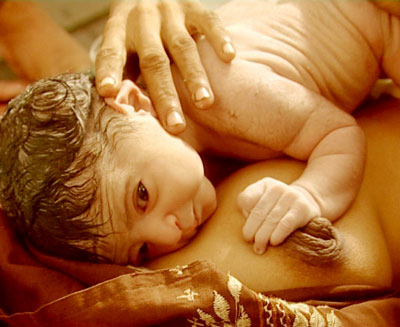
- Introduction
- How many babies successfully complete the Breast Crawl?
- What makes a baby capable of Breast Crawl?
- Advantages offered by Breast Crawl
- Hindering Factors
1. Introduction
Every newborn, when placed on her mother's abdomen, soon after birth, has
the ability to find her mother's breast all on her own and to decide when to
take the first breastfeed. This is called the 'Breast Crawl'. It was first
described in 1987 at the Karolinska Institute in Sweden (Widström et al,
1987). The description of the Breast Crawl, compiled from the article, is as
follows:
'Immediately after birth the child was dried and laid on the mother's
chest. In the control group a regular behavioural sequence, previously not
described in the literature, was observed. After 15 minutes of comparative
inactivity, spontaneous sucking and rooting movements occurred, reaching
maximal intensity at 45 minutes. The first hand-to-mouth movement was
observed at a mean of 34± 2 minutes after birth
and at 55+ minutes the infant spontaneously found the nipple and started to suckle.
These findings suggest that an organized feeding behaviour develops in a
predictable way during the first hours of life, initially expressed only as
spontaneous sucking and rooting movements, soon followed by hand-to-mouth
activity together with more intense sucking and rooting activity, and
culminating in sucking of the breast.'
Excellent photographs were included in the article and the word 'crawl'
appeared in the description of the photographs: 'The baby has crawled by
itself towards the nipple'
Many studies with different aims were published subsequently in relation to
the 'Breast Crawl'
- Study the effect of other hindering factors (Righard and Alade, 1990)
- Biological mechanisms for homing in on the nipple (Varendi et al, 1994; Varendi et al, 1996; Varendi and Porter, 2001)
- Advantages of the Breast Crawl (Widström et al, 1990; Christensson et al, 1992; Christensson et al, 1995; Matthiesen et al, 2001)
Klaus reviewed many of these studies and gave a beautiful description of the
Breast Crawl (Klaus 1998, Klaus and Kennel 2001). This inspired us to
include the Breast Crawl in our 'Lactation Management' curriculum and to
prepare this documentary. The credit for using the word 'Breast Crawl' as a
'noun' for the first time should be given to Klaus (1998). All previous
studies have used it as a 'verb'. The starting position for the 'Breast
Crawl' has been specified by Varendi et al (1994, 1996) i.e. nose in the
midline of the mother's chest, eyes at the level of the nipples.
2. How many babies successfully complete the 'Breast Crawl'?
The table below summarizes results from various studies about number of
babies completing the Breast Crawl.
Table 1
| Study |
Total babies under study |
Completing Breast Crawl |
Reaching the nipple but needing help to attach |
Not moving or not reaching the nipple |
| Widström, 1987 |
21 |
20 |
1 |
0 |
| Righard, 1990 |
17 (Controls) |
17 |
0 |
0 |
| Varendi, 1994 |
30 |
25 |
5 |
0 |
| Varendi, 1996 |
31 |
22 |
8 |
1 |
Babies completing the Breast Crawl with spontaneous attachment is
instinctive and almost a rule with very few requiring assistance.
3. What makes a baby capable of the 'Breast Crawl'?
A baby is born with many instinctive abilities which enable her to perform
the Breast Crawl. With all these innate programmes, the infant seems to come
into life carrying a small computer chip with the set of instructions. It
appears that young humans, like other baby mammals, know how to find their
mother's breast (Klaus and Kennel, 2001). The Breast Crawl is associated
with a variety of sensory, central, motor and neuro-endocrine components,
all directly or indirectly helping the baby to move and facilitate her
survival in the new world.
3.1 Sensory Inputs
Smell, vision and taste all help the newborn to detect and find the breast.
Auditory inputs and touch make her comfortable and help to create a suitable environment.
Olfactory / Visual / Taste / Auditory / Touch
3.1.1 Olfactory
This is the most studied input for the Breast Crawl and is believed to be
the most important. Babies preferred their mother's unwashed breast to her
washed breast, soon after birth. (Varendi et al, 1994). Besides secreting
milk and colostrum, the nipple and areola are dense in glands that perhaps
secrete attractive odours. Washing could have reduced or eliminated such
odours. This is consistent with a previous study (Makin and Porter, 1989)
where infants preferentially moved towards a gauze pad impregnated with the
breast odour of a lactating woman.
Later Varendi et al (1996) showed that within the first hour after birth,
significantly more babies spontaneously selected a breast treated with
amniotic fluid than the alternative untreated breast. This attraction
appears to be based on olfactory cues. Thus, amniotic fluid augments or
overrides the attractiveness of the natural scent of the mother' breast.
They postulated that observed attraction to amniotic fluid odour may reflect
foetal exposure to that substance (i.e. prenatal olfactory learning). They
also suggested that throughout the evolution of our species it was probably
common for women to handle their babies themselves during and following
delivery. Immediately after parturition, the mother's hands soiled with
birth fluids would transfer the amniotic fluid to her breasts when she first
attempted to nurse her neonate. This may be observed currently amongst
non-human primates. The data presented illustrates the importance of
maternal odours for newborn infants. Aside from guiding a neonate's overt
behavioural responses, such olfactory stimuli also appear to have a calming
effect on the infant and provide a basis for early individual recognition of
the mother.
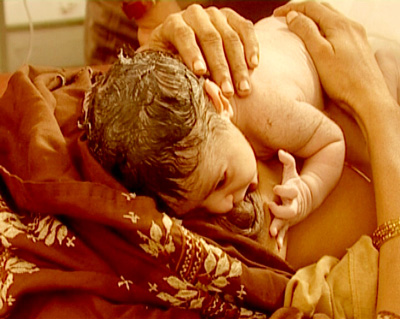
In 1998 Wineberg and Porter stated that about 1-2% of the human genome is
allocated to production of receptors for the olfactory epithelium - a hint
as to the possible importance of this chemical sense. Breast odours from the
mother exert a pheromone-like effect at the newborn's first attempt to
locate the nipple. Olfactory recognition may be implicated in the early
stages of the mother-infant attachment process, when the newborns learn to
recognize their own mother's unique odour signature - a process possibly
facilitated by the high norepinephrine release and the arousal of the Locus
Coeruleus at birth.
The mother is the source of an array of olfactory, visual, auditory and
tactile stimulation that the infant may perceive and respond to when placed
on her bare chest. In an attempt to elucidate further the role of olfaction
per se in early orientation to the breast, babies were observed when
additional maternal cues (e.g. voice, skin temperature and texture, body
form, heart and respiratory sounds and movement) were not available (Varendi
and Porter, 2001). A total of 22 babies were observed during the two trials
on a warming bed. In one trial, a pad carrying the mother's breast odour was
placed 17 cm in front of the baby's nose. In the other trial, a clean pad
was used. More babies moved towards and reached the breast pad than the
clean pad. It was concluded that natural breast odours unsupported by other
maternal stimuli are sufficient to attract and guide neonate to the source
of odour.
It appears that amniotic fluid contains some substance that is similar to a
certain secretion of the breast, albeit not the milk. The baby uses the
taste and smell of amniotic fluid on its hands to make a connection with a
certain lipid substance on the nipple related to the amniotic fluid. (Klaus
and Kennel, 2001)
3.1.2 Visual
Illingworth (1987) reviewed a number of studies of
the visual abilities of the newborn. They are listed as follows:
- Within minutes after birth, the infant follows a face like pattern more than other patterns of similar brightness.
- It will look at a black on white drawing of a face longer than three black dots on a white background.
- 40 newborn babies, at a median age of 9 minutes, turned their heads and eyes towards a moving stimulus. There was a greater response to a proper picture of a face than to a scrambled one.
The above studies indicate that organized visual
perception is an unlearned capacity.
Newborns can recognize their mother's face (Bushnell et al, 1989) and can
follow it for a short distance (Brazelton and Cramer, 1990).
In the past, most caretakers believed that the newborn needed help to begin
breastfeeding. So, immediately after birth, the baby was given to the mother
with its lips placed near or on the mother's nipple. In this situation, some
babies do start to suckle, but the majority just lick the nipple or peer up
at the mother. They appear to be much more interested in the mother's face,
especially her eyes, even though the nipple is right next to their lips. If
kept in between the mother's breasts, the infant usually begins with a time
of rest and quiet alertness during which she rarely cries and often appears
to take pleasure in looking at her mother's face. There is a beautiful
interlocking of gazes, at this early time, with the mother's interest in the
infant's eyes and the baby's ability to interact and to look eye to eye.
Visual interaction during the first few hours may explain the significantly
reduced incidence of abandonment later among babies who were given early
contact with suckling and who were roomed in. This may be partly due to the
special interest that mother's have, shortly after birth, in hoping that
their infant will look at them and to the infant's ability to interact
during the prolonged period of their quiet alert state in the first hour of
life (Klaus and Kennel, 2001).
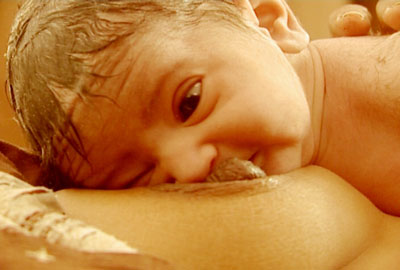
We are tempted to speculate that if a baby can appreciate her mother's face,
she can definitely see the areola and nipple (perceived as a dark spot on a
lighter background). This is consistent with Illingworth (1987) stating that
a newborn baby shows more interest in a black and white pattern than in a
blank grey card. Perhaps that is the main reason why the areola is
hyperpigmented. This is in sharp contrast to animal breasts / nipples. Does
this point to a possibility that as compared to young animals, human babies
may be also vision dependent in homing on to the nipple?
3.1.3 Taste
Amniotic fluid on the infant's hands probably also
explains part of the interest in suckling the hands and fingers. The baby
uses the taste and smell of amniotic fluid on its hands to make a connection
with a certain lipid substance on the nipple related to the amniotic fluid
(Klaus and Kennel, 2001).
3.1.4 Auditory
The mother's voice is reported to be the most
intense acoustic signal measured in the amniotic environment. A preterm
foetus also is capable of responding to speech stimuli. Both the newborn and
the foetus show heart rate decelerations in response to speech sounds.
Newborn infants prefer the sound of the maternal voice and also suckle for
longer when they hear it (DeCasper and Fifer, 1980; Fifer and Moon, 1994).
They can discriminate the language heard in utero from another language
(Mehler et al, 1988). Thus, the mother's voice is a naturally occurring and
salient stimulus during a critical time period in which there is significant
development in several psychobiological systems.
Given these abilities of the newborn, the Breast Crawl offers the best
chance for auditory stimulation with the natural voice of the mother, which
the newborn is accustomed to in utero. However, it is also important to
encourage mothers to initiate conversations with the baby in the antenatal
period and to continue conversing in the early tender moments soon after
birth. This may not only comfort the baby but also may have a bearing on development.
The rhythmic sound of the mother's heart-beat can also have a calming
influence on the baby. Sounds that imitated heart beats at a frequency of
about 70 per minute, during the first few days, not only calmed the baby but
also reduced postnatal weight loss (Salk L, 1960; Salk L, 1962).
Early experiences with voices have both acute and enduring effects on the
developing brain. These effects have ramifications for the development of
the auditory system, as well as for later social and emotional development (Fifer and Moon, 1994).
Thus, the Breast Crawl provides continuity in auditory stimulation and
development during transition from intrauterine to extrauterine life.
3.1.5 Touch
Skin to skin touch provides heat and variety of other
tactile inputs. It offers benefits at many levels:
- Helps maintain temperature (Christensson et al, 1992)
- Facilitates metabolic adaptations especially sugar levels and acid-base balance (Christensson et al, 1992)
- Results in less crying (Christensson et al, 1992; Christensson et al, 1995)
- Facilitates bonding (Widström et al, 1990)
- Causes oxytocin release in the mother
- Improves immediate and long term breastfeeding success: (Righard and Alade, 1990; WHO, 1998; DeChateau and Wiberg, 1977)
All these benefits are discussed in detail later on.
3.2 Central Component
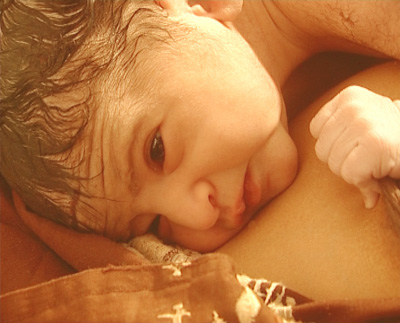
After birth, the healthy newborn often undergoes a quiet alert phase, which
has been referred to as the first phase of reactivity. When placed skin to
skin on a mother's chest shortly after birth, the infant often becomes quiet
and starts exploring its environment (D'Harlingue and Durand, 2001). Infants
separated from their mothers cry excessively.
Widström et al (1987) recorded a state of wakefulness during the Breast
Crawl according to Brazelton's Neonatal Behaviour Assessment Scale (BNBAS).
At 15 minutes, the children's median state was 4. Alertness gradually
decreased until 150 minutes after birth, when they were all asleep.
This confirms that the newborn's brain is optimally ready to integrate
various sensory inputs and other components of the Breast Crawl soon after
birth. If initiation is not attempted soon after birth, a vital period of
alertness will be lost – the newborn will go off to sleep and the first
breastfeed may be delayed for several hours. This delay leads to baby
loosing out the benefits of early initiation.
3.3 Motor Outputs:
Orofacial / Lower Limbs / Upper Limbs / Salivation
3.3.1. Orofacial:
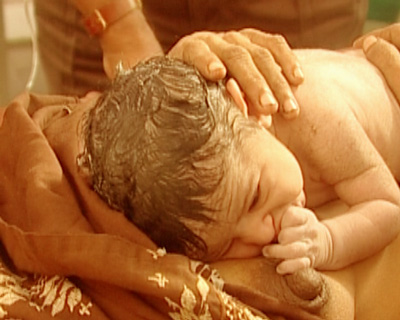
Around 30-40 minutes after birth, the newborn begins making mouthing
movements, sometimes with lip smacking. Suckling of hands and fingers is
commonly seen. After attaching successfully, newborns continued to suckle
for 20 minutes (Righard and Alade, 1990).
Table 2
| Study |
Widström, 1987 |
Varendi, 1996 |
| Intensity of Suckling |
Low in first 15 mins. of birth
Peak at 45 mins.
Absent by 150 mins. |
- |
| Intensity of Rooting |
Low in first 15 mins. of birth
Peak at 60 mins.
Absent by 150 mins. |
Onset: 11-66 mins. (Median:25) for amniotic fluid treated breast
Onset: 16-58 mins. (Median:30) for natural breast |
| First Hand to mouth |
34 (Mean) + 2 mins. |
14-45 mins. (Median:32) for Amniotic Fluid Treated breast
22-45 mins. (Median:29.5) for natural breast |
| Onset of breastfeeding |
55 (Mean) + 4 mins. |
17-88 mins. (Median:46.5) for amniotic fluid treated breast
38-103 mins. (Median:52) for natural breast |
3.3.2 Lower Limbs
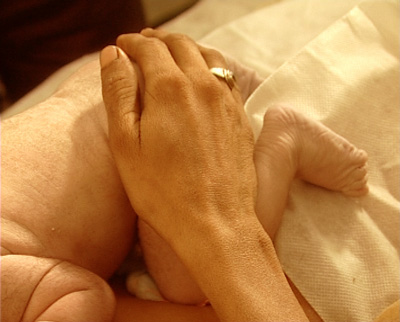
The Stepping Reflex helps the newborn to push against her mother's abdomen
to propel her towards the breast. Pressure from the infant's feet on the
abdomen may also help to expel placenta and reduce uterine bleeding (Klaus
and Kennel, 2001). Righard and Alade (1990) observed that arm and leg
movements started after a mean of 49 mins (SD: 7.8).
3.3.3 Upper limbs
Horizontal motion is achieved by using small push ups and lowering one arm
first in the direction they wish to go. The ability to move its hand in a
reaching motion enables the baby to claim the nipple. This helps to
stimulate, elongate and protract the nipple (Klaus and Kennel, 2001) and
facilitates attachment. When the baby massages the breast and subsequently
suckles, a large oxytocin surge is induced from the mother's pituitary gland
into her bloodstream. This also helps in the manufacture of prolactin.
Muscular strength in the neck, shoulders and arms helps newborns to bob
their heads and do small "push ups" to inch forward and side to side.
The efforts to reach the breast are interspersed with short periods of rest.
Sometimes babies change direction in midstream.
3.3.4 Salivation
Salivation occurs in anticipation that the food is in close proximity.
3.3.5 Neuro-endocrine Component
It is widely known that oxytocin (sometimes called the love hormone) is
released in the mother's blood by the posterior pituitary gland. This
oxytocin is in fact produced by the hypothalamic neurons and reaches the
posterior pituitary gland through their axons. It is responsible for the
letdown of milk and contraction of the uterus. In humans, there is a blood
brain barrier for oxytocin, and only small amounts reach the brain via the
blood stream.
The lesser known fact is that de novo oxytocin synthesis occurs in both the
infant's and mother's brain when breastfeeding occurs. The stimuli for this
release are touch on the mother's nipple and the inside of the infant's
mouth. This oxytocin, acting on multiple oxytocin receptors in the brain
(Klaus and Kennel, 2001) plays the following roles:
- Stimulation of the vagal motor nucleus, releasing 19 different gastrointestinal hormones including insulin,
cholecystokinin and gastrin (Tafari and Ross, 1973). Five of these 19 hormones stimulate growth of the baby's and mother's villi and
increase the surface area and the absorption of calories with each feeding (Uvnas-Moberg, 1989).
- Important for the initiation of maternal behaviour and for the facilitation of bonding between the mother and the baby (Klaus and Kennel, 2001).
- In mothers it results in slight sleepiness, euphoria, increased pain threshold and feeling of increased love for
the infant. It appears that, during breastfeeding, elevated blood levels of oxytocin are associated with increased brain levels; women
who exhibit the highest plasma oxytocin are the sleepiest (Klaus and Kennel, 2001).
4. Advantages offered by the Breast Crawl
The promotion of early initiation of breastfeeding has great potential: 16%
of neonatal deaths could be saved if all infants were breastfed from day 1
and 22% if breastfeeding were started within the first hour after birth
(Edmond et al, 2006).
Several other advantages of early initiation have been mentioned in the
FAQ section.
These are listed along with references in the
International Lactation Consultant Association document (ILCA, 2005).
All these advantages will obviously be maximally tapped with Breast Crawl.
We present some of these advantages where such evidence is available: For
Baby / For Mother / For Both
4.1 For the Baby
Warmth / Comfort / Metabolic adaptation / Quality of attachment
4.1.1 Warmth
Christensson et al (1992) compared temperatures of newborns kept in
skin-to-skin contact in the Breast Crawl position with those kept in a cot
in the first few hours after birth. They found that the former had better
body and skin temperatures. They concluded that the mother is an important
heat source for the newborn. From an evolutionary perspective, the mother's
body must have been the only reliable source of heat for the newborns. The
natural body to body contact may have been part of a genetic programme for
maternal behaviour, which is worthwhile protecting.
These findings would be especially valuable in those developing countries,
where the incidence of neonatal hypothermia has been reported to be high and
associated with an increased morbidity and mortality rates.
4.1.2 Comfort
The transition from life in the womb to existence outside the uterus is made
easy by the various sensory inputs in the Breast Crawl position.
In this position, the infant can experience sensations somewhat similar to
that felt during the last several weeks of intra-uterine life. It is likely
that each of these features – the crawling ability of the infant, the
decreased crying when close to the mother, and the warming capabilities of
the mother's chest-are adaptive features that have evolved to help preserve
the infant's life (Klaus and Kennel, 2001).
Christensson et al (1992) compared crying between babies kept in the Breast
Crawl position with those kept in a cot next to the mother during the first
90 minutes after birth. The infants in the cot cried for a significantly
longer time than the babies in Breast Crawl position during all observation periods.
Table 3: Crying duration at various time intervals
| Group |
Time Interval |
| At 25-30 mins. |
At 55-60 mins. |
At 85-90 mins. |
| Babies in skin-to-skin contact (Breast Crawl) |
60 seconds |
0 seconds |
10 seconds |
| Babies in cot |
1094 seconds |
985 seconds |
760 seconds |
On the basis of these observations, authors concluded that the infants in cot cried for a significantly longer time than the
babies in skin-to-skin contact during all observation periods.
A similar study (Christensson et al, 1995) objectively evaluated
differences in crying when infants were cared for by one of three
methods during the 90 minutes following birth:
- Skin to skin contact (Breast Crawl): 90 mins.
- In a cot next to the mother: 90 mins.
- In a cot next to the mother for the first 45 minutes and then skin to skin contact (Breast Crawl) for next 45 mins.
Results suggested that human infants recognize physical
separation from their mothers and start to cry in pulses. Crying stops
at reunion. The observed cry may be a human counterpart of the
'separation distress call' which is a general phenomenon among several
mammalian species and serves to restore proximity to the mother. The
results suggest that in human newborns this cry is not dependent on
earlier social experience and may be a genetically coded reaction to
separation. Whatever the evolutionary foundations, this cry seems to
signal that care in a cot does not satisfy the needs of the newborn
human baby. Authors recommend that the most appropriate position of the
healthy full term newborn baby after birth is in close body contact with
the mother. This was ensured in the study by keeping the babies in the
Breast Crawl position.
4.1.3 Metabolic adaptation
Babies kept in the Breast Crawl position had higher 90 minute blood sugar
levels and more rapid recovery from transient acidosis at birth, as
compared to babies separated and kept in a cot next to the mother
(Christensson et al, 1992).
4.1.4 Quality of attachment
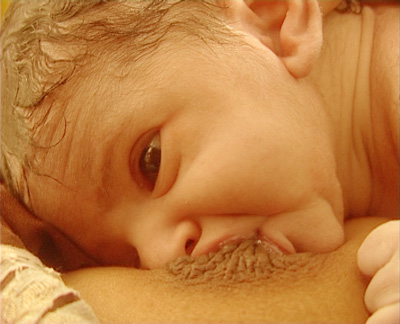
Of 17 babies kept in the Breast Crawl position and kept in uninterrupted
skin-to-skin contact for 1 hour, 16 attached to the breast correctly.
Fifteen babies in the other group were separated after about 20 minutes for
routine measuring and weighing procedures. After an interval of
approximately 20 minutes, they were returned to the mother. Only seven
babies in this group attached correctly (Table 4). These findings are
crucial because the early suckling pattern is of prognostic value for the
duration and success of breastfeeding (Righard and Alade, 1990).
4.2 For the Mother
Expulsion of placenta and reduction of postpartum haemorrhage
This occurs by the following mechanisms
- As mentioned earlier, massage of the breast by the baby and subsequent
suckling induce a large oxytocin surge from the mother's pituitary gland
into her bloodstream. Close emotional interaction coupled with cutaneous,
visual and auditory stimuli from the baby during the Breast Crawl also help
oxytocin release. This oxytocin helps to contract the uterus, expelling the
placenta and closing off many blood vessels in the uterus, thus reducing
blood loss and preventing anaemia.
- Pressure of the infant's feet on the abdomen may also assist in expelling the placenta (Klaus and Kennel, 2001).
Nissen et al (1995) showed that with the baby in Breast Crawl position, the
blood level of oxytocin soon after delivery was elevated significantly
compared with that postpartum. The level returned to its pre-partum value 1
hour after delivery. The peak oxytocin level was seen 15 minutes after
delivery with expulsion of placenta. Most mothers had several peaks of
oxytocin occurring up to 1 hour after delivery.
4.3 Advantages for Both: Bonding
A mother's feeling of love for the baby may not necessarily begin with birth
or instantaneously with the first contact. During the Breast Crawl, while
resting skin to skin and gazing eye to eye, they begin to learn about each
other on many different planes. For the mother, the first few minutes and
hours after birth are a time when she is uniquely open, emotionally, to
respond to her baby and to begin the new relationship. Suckling enhances the
closeness and new bond between mother and baby. Mother and baby appear to be
carefully adapted for these first moments together (Klaus and Kennel, 2001).
Many studies have addressed the question of whether there is what has been
called a 'sensitive period' for parent-infant contact in the first minutes,
hours and days of life that may alter the parent's behaviour with their
infant later in life. In each study, increasing the mother-infant time
together or increased suckling improves caretaking by the mother (Klaus and Kennel, 2001).
Researchers have also observed that mothers exhibit a very orderly and
predictable set of behaviour when they first see and come into contact with
their newborns. They begin by hesitantly touching the infant's extremities
with their fingertips. Within four or five minutes, they begin caressing the
child's trunk with the palm, simultaneously showing progressively heightened
interest that continues for several minutes. By the end of nine minutes,
fingertip touch has dropped substantially, palm contact has more than
doubled, and touch now emphasizes the trunk rather than the extremities. (Klaus et al, 1970)
If nurses spend as little as 10 minutes helping each mother discover some of
their newborn infant's abilities, such as turning towards the mother's voice
and following the mother's face and assisting mothers with suggestions about
ways to quieten their infants, the mothers become more appropriately
interactive with their infants face to face and during feeding at 3- 4
months of age (Brazelton and Cramer, 1990).
If the lips of the infant touch the mother's nipple in the first hour of
life, a mother will decide to keep her baby 100 minutes longer in her room
every day during her hospital stay than another mother who does not have
contact until later (Widström et al, 1990).
Extended early contact in the first few days helps prevent parenting
disorders including child abuse, failure to thrive, abandonment and neglect later on.
The behaviour described in these studies can be partly explained by de novo
release of oxytocin in both the mother's and infant's brain when an infant
suckles from the breast (Klaus and Kennel, 2001) (discussed in section 3.3.5).
5. Hindering Factors
Righard and Alade (1990) studied the effect of separation on the Breast
Crawl in 72 infants. In the separated group (n=34), the infant was placed on
the mother's abdomen immediately after birth but removed after 20 minutes
for measuring and wrapping. These routines took about 20 minutes after which
the infant was returned to the mother. In the contact group (n=38) contact
between mother and infant was uninterrupted for at least one hour after
birth. Of the 72 mothers, 40 (56%) received pethidine during labour. The
suckling technique was studied in both the groups. The results of the study
were tabulated and are as follows:
Table 4
| Total 72 newborns |
Suckling Pattern |
Still not suckling
2 hrs after birth |
| Correct |
Incorrect |
| Contact Group (38) |
| No Pethidine (17) |
16 |
1 |
0 |
| Pethidine (21) |
8 |
3 |
10 |
| Separation Group (34) |
| No Pethidine (15) |
7 |
7 |
1 |
| Pethidine (19) |
0 |
4 |
15 |
Authors concluded that brief separation of the infant from the mother during
the first hour after birth had a strong effect on the success of the first
breastfeed, as did pethidine given during labour. Of infants both separated
and exposed to pethidine through their mothers, not one breastfed
successfully, whereas almost all those who were neither separated nor
exposed to pethidine succeeded in adopting the correct breastfeeding
technique. Thus, the two crucial determinants for a successful start to
breastfeeding seem to be uninterrupted contact with the mother until after
the first feed and no sedation of the infant by analgesics given to the mother during labour.
A side effect of such narcotic analgesics as pethidine is central nervous
system depression, in both the mother and the infant. The plasma half life
of pethidine is 3.0-4.5 hours in the mother, but as long as 13-23 hours in
the infant (62 hours for the active metabolite, normeperidine).
Consequently, the infant is depressed for much longer time than the mother.
The plasma concentration of pethidine in the infant is almost as high as
that in the mother, reaching a maximum after 2-3 hours, after which the
level falls slowly. In this study, more infants were alert, ready to suckle
and suckled correctly, when the time between analgesia and the delivery room
was below 2 hours than when it was longer.
Separation for measuring and wrapping procedure after 15 to 20 minutes of
skin to skin contact seriously disturbed the first breastfeed. This time
seems to be a very critical stage for separation; just when the infant was
about to start crawling movements, she was removed. The infants generally
protested loudly when removed. There is no justifiable reason for routine
separation - measuring and weighing procedures can simply be put off for 1-2 hours.
Authors recommended that
- The naked infant should be left undisturbed on the mother's abdomen until the first breastfeeding is accomplished, and the
infant's efforts to take the breast actively should be encouraged.
- The use of drugs given to the mother during labour should be restricted.
To allow the Breast Crawl to be successful, Klaus and Kennel (2001) strongly
urge that the injection of vitamin K, application of eye ointment, washing
and any measuring of infant's height, weight and head circumference be
delayed for at least 1 hour. In order not to remove the taste and smell of
the mother's amniotic fluid, it is necessary to delay washing the baby's
hands. This early hand-sucking behaviour is markedly reduced when infant is bathed before the crawl.
As stated earlier, olfaction plays a great role in guiding the newborn to the
breast. A substance secreted by the nipple is thought to be responsible.
Based on this Varendi et al (1994) stated that unnecessary routine cleaning
of the breast may interfere with the establishment of successful early
breastfeeding by elimination of the infant's access to biologically relevant chemical signals.
The same researchers in 1996 stated that excessive use of products that
eliminate or mask natural odour signals (deodorants and perfumes) should
perhaps be avoided during the perinatal period.
Birth practices can affect breastfeeding, particularly initiation. These
practices are important, in their own right, for the physical and
psychological health of the mothers themselves. They also have been shown to
enhance infants' start in life, including how they breastfeed (UNICEF-WHO,
2006). In 2006, authorities of the WHO / UNICEF Baby-Friendly Hospital
Initiative added an optional component to the baby-friendly assessment
tools, which examines mother-friendly care. Each country will determine
whether it will integrate this module as it updates assessment criteria and
tools to the new standards (Lothian, 2007). Implementing '
Ten
Steps of Mother Friendly Care' will facilitate successful initiation
(Breast Crawl). Hence, every maternity service should consider implementing these steps.
Dos and Don'ts for success of the Breast Crawl
For the Mother
- Use drugs for labour analgesia judiciously.
- Do not wash / wipe breast before feeding.
- Raise mother's head on a pillow to facilitate mother-baby visual contact.
- Do not move mother out of labour room until completion of the first breastfeed.
For the Baby
- A baby who has cried well does not need oro-nasal suction.
- Dry the baby thoroughly except for the hands.
- Do not pass orogastric / nasogastric tube or do gastric suction as a routine.
- The baby and the mother should be covered together with a cloth, so that they keep warm while continuing with skin-to-skin contact.
- Delay the injection of vitamin K, weighing, routine measuring and dressing (wrapping) till after the first breastfeed.
- Baby bath is best delayed to beyond 24 hours.
- Continue the first skin-to-skin contact till completion of the first breastfeed.

